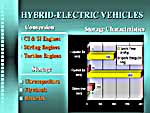|

Hybrid-Electric Vehicles
Conversion and Storage Characteristics

Slide 8 of 13
Click image to enlarge.
For top quality images and fast viewing,
download the native PowerPoint file from the contents page.
|
Notes:
Hybrids are a hot subject today, but they are the most complex vehicles to correctly
design and the most complex to adequately discuss. In my opinion, the go-anywhere
family sedan of year 2010 and beyond will likely be some form of hybrid vehicle. The
deciding factor hinges mainly on the economics of producing a complex hybrid power system,
rather than the inherent capabilities of the technology itself.
Hybrid power systems began as a way to make up for the shortfall in battery technology.
Since batteries could supply only enough energy for short trips, then an onboard
ICE-powered generator could be installed and switched on for longer trips in order to
extend range. In the old days, we thought that by biasing the system toward
battery-electric power and operating on wall-plug electricity as much as possible,
efficiency and emissions would then be about as optimal as one could hope for until better
batteries came along. The natural conclusion of this concept was that, with better
batteries, we probably would not need hybrids at all. But after some 20 years of
study, it’s beginning to look as though a correctly designed hybrid vehicle may
actually be just as clean (+/- 10%) and energy efficient as a battery-electric car, and
perhaps even cleaner and more energy efficient (considering the entire fuel chain, and
depending on the source fuel used to generate electrical power).
There are lots of possible configurations with a hybrid vehicle. On a fundamental
level, a hybrid combines an energy storage system, an energy conversion system, and a
vehicle propulsion system. Normally, the genset is rated according to an average
trip demand level and the storage system supplies power for peak demands.
The primary options for energy storage include batteries, ultracapacitors, and
flywheels. Conversion system options include reciprocating engines, turbines,
stirling cycle engines, and fuel cells. Propulsion can come entirely from an
electric motor, such as in a series hybrid, or the engine might provide direct mechanical
input to the vehicle propulsion system in a parallel hybrid system (rather than producing
electrical energy). A hybrid’s efficiency and emissions depend on the
particular combination of subsystems, how these subsystems are integrated into a complete
system, and the control strategy and biasing between subsystems. A fuel cell hybrid,
for example, would produce only water as a by-product and run at greater overall
efficiency than today’s battery-electric vehicles using wall-plug electricity.
The hybrid’s inherent complexity, and the fact and some of the best storage and
conversion systems have yet to be fully developed is responsible for the varied opinions
on a hybrid’s energy efficiency, environmental benefits, and manufacturing costs.
In addition to technical capability, enormous economic challenges also have to be
overcome in order to produce a refined hybrid vehicle that sells for about the same as a
conventional family sedan.
|
|
|